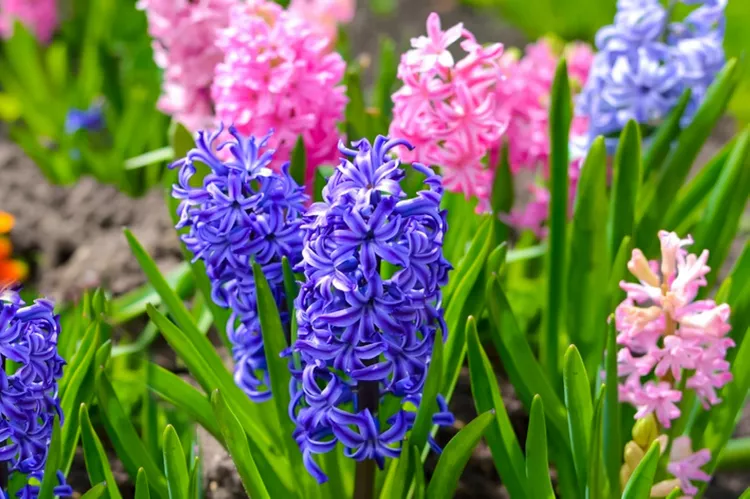
Hyacinth flowers, which were once a light blue or violet color, now appear in a wide range of hues, including lilac, pink, white, cobalt blue, cream, apricot, and even a blood-red shade. Typically, each hyacinth bulb yields one flower stem that is between 8 and 10 inches tall. The single or double flowers that make up the loose to dense racemes (clusters) of the hyacinth’s strong-scented blossoms can be arranged tightly together.
Care

Light
Hyacinths prefer either full sun or little shade. At least six to eight hours of sunlight should be provided to the plants each day. Hyacinths bud, bloom, and begin to fade before deciduous trees fully leaf out, just like all spring bulbs, so you don’t have to be concerned about too much shade from neighbouring trees.
Soil
Although hyacinth bulbs do not care much about the pH of the soil, they do favour a slightly acidic to neutral soil. Additionally, they thrive in loose, well-drained soil; they cannot grow in moist soil. When preparing or amending the soil, be careful not to add too much organic matter because this can result in floppy stalks.
Water
After planting the bulbs, thoroughly water the earth. If there are not any frequent downpours, keep watering over the winter, but let the ground dry out in between applications. The bulbs will eventually decay if they remain in cool, moist soil. Only water when the ground is completely dry after checking it with your finger in the hole. Typically, depending on your environment, this occurs once or twice every week. Hyacinths typically need about 1/2 inch of water each week from irrigation and rainfall combined. However, how effectively the earth drains will determine this.
Temperature and Humidity
In USDA plant hardiness zones 4 to 8, hyacinths should be able to withstand the winter months. Depending on the variety, they could require some pre-chilling in warmer zones and some winter protection in colder zones. Dig up the bulbs and refrigerate them for six to ten weeks somewhere dark and cold before replanting them in areas where winter temperatures are expected to stay over 60 degrees Fahrenheit.
Fertilizer
When planting new bulbs, dumping some bulb food into the hole is the simplest way to feed them. For feeding bulbs, there are numerous fertilizers available; 10-10-10 is advised; alternatively, you can use regular bone meal. During planting, give the bulbs a little handful of fertilizer. Then, in the spring, when the first signs of new growth appear, give them another handful of fertilizer. Follow the directions on the product packaging for how much to use.
Types of Hyacinth
Hyacinths of today come in a variety of hues. Several types include:
‘Hollyhock’: offers eye-catching double reddish-pink blooms.
‘Pink Pearl’: has fuchsia flowers with faint pink edges.
‘Woodstock’: with rich plum petals
‘Blue Jacket’: has rich purple-blue blooms and a denser bloom structure.
‘Top White’: offers star-shaped, dazzling white flowers.
Potting and Repotting
The depth of the container should be about 6 inches. How many bulbs you are planting determines the breadth of the container. Hyacinth bulbs planted in pots do not need as much space to spread out as those planted in the ground, so they can be planted closer together. You can close the space between them so that they are practically touching, but allow enough area for some soil to fill it with water. In the event that your bulbs are appropriately spaced, repotting should not be required.
Hyacinths can be grown in containers with regular commercial potting soil, though some gardeners prefer to add a little sand to the soil mixture. Till the bulbs sprout, keep the potting soil moist but not drenched. Then, irrigate the soil anytime it becomes dry. Move the bulbs to indirect sunlight once they have sprouted. Cooler temperatures will prolong their bloom.
Table





